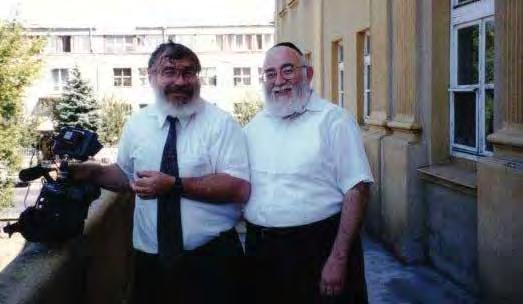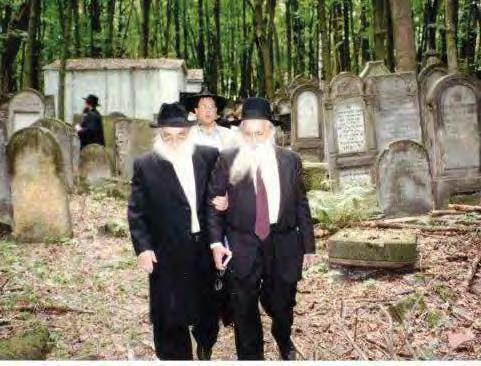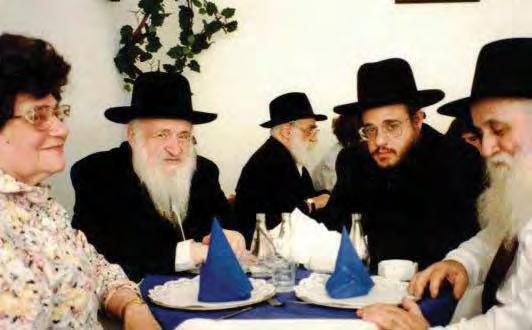
7 minute read
The Wandering Jew
The Wandering Jew Siyum in Lublin
Part I
Advertisement
By Hershel Lieber
This story actually began way before 1996. My friend, Menachem Daum, is my brother-inlaw’s brother. We became close soon after our families merged in 1972, and when we started davening together in the Gerrer Shtiebel, our relationship intensified. We had a lot in common in that we both were mesmerized with “the Old Country,” Poland, and its prewar Jewish history. I traveled there often, and Menachem made a number of trips there as well. We shared our insights and experiences, and though we may have differed on some issues, there was so much common ground that kept us comfortably unified. Menachem is a noted filmmaker whose highly acclaimed films “A Life Apart” and “Hiding and Seeking” brought him recognition beyond our immediate community. Menachem’s talent was sought after for filming weddings and other life cycle events, and I have used him often.
Throughout our relationship, I was aware of Menachem’s fascination with Harav Meir Shapiro, the Lubliner Rav. He read a lot about him, researched his biographical information, pored over photographs and newspaper accounts, and filmed interviews with the Rosh Yeshiva’s talmidim, such as Rabbi Mordechai Yehuda Lubart. He was
Yeshivas Chachmei Lublin
awed by the Lubliner Rav’s multi-faceted talents and his vigorous energy that made him such an accomplished leader at a relatively young age. Menachem’s dream was to produce a documentary about Rabbi Meir Shapiro, a dream that he finally realized with the production of “Only with Joy” in 2020.
In 1996, Menachem approached me with a novel idea. He proposed that I organize a trip to Poland with the centerpiece of that journey being a siyum of a Daf Hayomi Mesechta in the original building of the famed Yeshivas Chachmei Lublin. He, of course, would join and film the event.
Instinctively, I took on the challenge without thinking much about the logistics. When I started mapping out an outline of the trip with Menachem, I realized how much of a novice I really was and that I had to connect this project with a travel agency that specializes in travel to Poland. The most fitting person I could think of was Rabbi Nachman Elbaum of Ideal Travel, whom I have dealt with previously concerning Poland.
After meeting with him, we divided the duties of organizing the journey, which was named “Return to Lublin.” I would be in charge of advertising and promoting the event, planning an itinerary, and getting the permission of the authorities to hold the siyum in the former Yeshiva building, which was, at that time, a medical college. Nachman would be in charge of airline and tour bus arrangements and the hotels that we would stay at. We both would share the responsibility of the food requirements. The six-day trip was planned for August 8, and during the months preceding that date, I was quite occupied to ensure that everything would be in place and the plans well organized.
That summer, Pesi and I were in Poland for the Ronald Lauder Summer Retreat. We planned to be there from August 1 for three weeks. We arranged to take off from our lecturing at the retreat for six days so I could lead the “Return to Lublin” journey.
We traveled to Warsaw from the retreat, which was located in the Beskids Mountains in southern Poland. I met Rav Nachman in the Nozyk Shul, and we went to the airport to meet our group. The larger group of fourteen people arrived in the morning, and six others joined us later in the day. Among our group were a number of personalities including Rav Yaakov Finkelstein and his son Ruvain from the Yeshiva of Bayonne, Rav Lipa Margulies and Rabbi Yakov Applegrad from Yeshiva Torah Temimah, and Rabbi Chaim Fuhrer and Rabbi Yosel Schiff. Most of the men came with their wives. Rav Chaskel Besser and his son Naftali, Menachem Daum, and Avraham Horowitz from Israeli TV arrived later in the day and went directly to Lublin.
Our first day consisted of a jampacked program. We traveled by coach bus, and our first stop in Warsaw was the second-largest cemetery in Poland. The bais olam has the kevarim of countless rabbanim, roshei yeshivos and admorim. We walked around with the help of Jan Jagielski, an expert on Jewish Polish history for over an hour, making many stops to be mispallel at the gravesites of so many tzaddikim.
Our next stop was at the Jewish museum, where the assistant director, Grazina Pawlak, presented a short version of the account of the Warsaw Ghetto. We continued to the


Rav Yaakov Finkelstein and Rav Nachman Elbaum in the Warsaw cemetery The matzeivah of the Chozeh of Lublin At the ohel of the Chadushei HaRim and the Sfas Emes

Umshlagplatz, from where Jews were deported to Treblinka; Mila 18, where the last of the Ghetto fighters met their death; and finally, to the monumental Ghetto Uprising memorial. From there, we went to see the Nozyk Shul, the only surviving prewar synagogue out of over four hundred, and then for dinner at the Menorah Restaurant. We continued on to Gura Kalwaria, to the shul of the Gerrer Rebbes where we davened Mincha, and then to the bais olam to the Ohel of the Chaddushei HaRim and the Sfas Emes. We still had an over three-hour ride ahead of us to Lublin. When we arrived at the Hotel Unia, we were all so tired that we davened Maariv and went to sleep immediately.
The next day was the big day! After Shacharis in the hotel, I took the group to the old bais hachaim. We said Tehillim by the kevarim of the Chozeh of Lublin, the Maharshal, Rav Yaakov Pollack and Rav Sholem Schachne (father-in-law of the Rema). The group continued on to the infamous extermination camp Majdanek, just outside the city, with Reb Nachman offering the tragic narrative of this notorious death factory. In the meantime, Pesi and I, with the help of Menachem, ran out to buy some fruit, drinks, and paper goods for the celebration after the siyum. We worked vigorously and
swiftly to set up the snacks. The group returned a bit after noon, and a bus arrived simultaneously with participants of the Lauder Summer Retreat led by Rabbi Michael Schudrich. A small number of local Jews also participated. The yeshiva building, which was not returned to the Jewish community until 2003, was still an active medical college. The lecture hall and balcony, which were still being used by the college, was the original bais medrash of the yeshiva, which was used both for studying and davening. This is the hall where I set up a head table on the platform facing the guests.
In total, I would say about one hundred people attended. The dais
was graced by Rabbis Besser, Elbaum, Finkelstein, Schiff and Schudrich. I was the master of ceremony. The siyum on Mesechta Sanhedrin was made by Rav Chaskel Besser, who also addressed the gathering in and Yiddish and Polish. Mesechta Makos was started by Rav Yaakov Finkelstein. Rabbi Schiff spoke in Hebrew, and Rabbi Schudrich addressed the assembled in Polish. The atmosphere at this event was very festive and was followed by singing and dancing and refreshments. The entire program was filmed both by Menachem and Israeli TV. The event was truly unique, since it was more than fifty-five years that the sound of Torah had not been heard in this legendary building. On this day, the sentiments of all the participants were united with the legendary Rav Meir Shapiro as his dream was renewed.
Hershel Lieber has been involved in kiruv activities for over 30 years. As a founding member of the Vaad L’Hatzolas Nidchei Yisroel he has traveled with his wife, Pesi, to the Soviet Union during the harsh years of the Communist regimes to advance Yiddishkeit. He has spearheaded a yeshiva in the city of Kishinev that had 12 successful years with many students making Torah their way of life. In Poland, he lectured in the summers at the Ronald S. Lauder Foundation camp for nearly 30 years. He still travels to Warsaw every year – since 1979 – to be the chazzan for Rosh Hashana and Yom Kippur for the Jews there. Together with Pesi, he organized and led trips to Europe on behalf of Gateways and Aish Hatorah for college students finding their paths to Jewish identity. His passion for travel has taken them to many interesting places and afforded them unique experiences. Their open home gave them opportunities to meet and develop relationships with a variety of people. Hershel’s column will appear in The Jewish Home on a bi-weekly basis.












